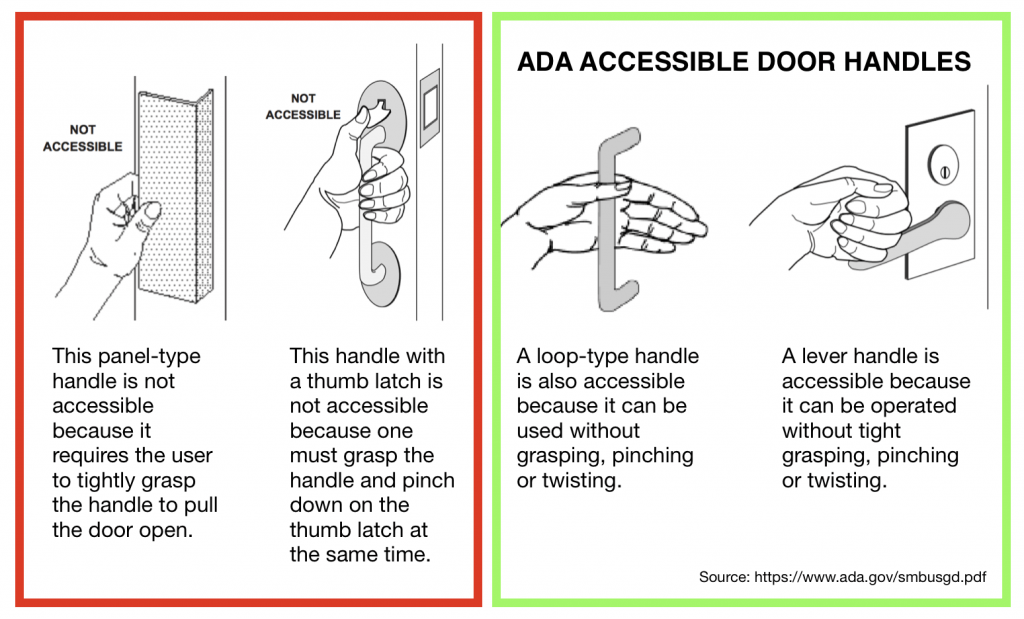ADA Construction Projects
Minnesota ADA Compliance General Contractor
The Americans with Disabilities Act (ADA) became law in 1990. The ADA is a civil rights law that prohibits discrimination against individuals with disabilities in all areas of public life, including jobs, schools, transportation, and all public and private places that are open to the general public. Randahl Construction, Inc. is a general contractor based in Minnesota that assists local businesses in making ADA improvements and updates to their facilities. We have developed this article featuring useful tools to educate and provide our clients with valuable information about the Americans with Disabilities Act.
Does Your Business need to be ADA Compliant?
The ADA requires businesses to make “reasonable accommodations” for people with qualified disabilities, but only if those businesses fit certain guidelines. So the question becomes, how can I tell if my business is required by the ADA to make those reasonable accommodations. Some portions of the Americans with Disabilities Act contain an exemption for businesses that employ fewer than 15 people, for example, while other provisions apply to companies that provide services to the public, regardless of size. How can you tell if your business is required to conform? Here are the facts, according to ADA, to help you decide.
General Contractor Estimates & Pricing When you include Randahl Construction in your bidding process, you can have confidence that you will be getting a REAL NUMBER. Our trained estimators and project managers work together to ask all of the right questions ensuring that the project is bid properly. Our proposal process begins with a site visit, visiting the potential construction site while asking all of the necessary questions. Randahl Construction carefully examines your construction site beforehand to ensure that your building plans work well with the land (or existing structures) – so there won’t be any surprises after you get our estimate. We often times bring our subcontractors into the walk-through with us during the bidding stages because we believe in hands on numbers that are accurate and real. We don’t just select our subcontractors based on who has the lowest bids; we choose the most experienced crews with the best reputations for your type of project.
Helpful Information from the ADA Guide for Small Businesses by U.S. Department of Justice Civil Rights Division
Doors at Entrances to Businesses
Most entrances to stores and businesses use 36 inch wide doors that are wide enough to be accessible. However, some older doors are less than 36 inches wide and may not provide enough width (32 inch clear width when fully opened). Door openings can sometimes be enlarged. It may also be possible to use special “swing clear” hinges that provide approximately 1 1/2 inches more clearance without replacing the door and door frame. Inaccessible door hardware can also prevent access to the business. For example, the handle shown below requires the user to tightly grasp the handle to open the door. Many people with mobility disabilities and others with a disability that limits grasping, such as arthritis, find this type of handle difficult or impossible to use.

Changing Your Door Hardware to Comply with ADA Regulation
ADA Compliance in New Construction & Remodeling
New Construction and Alterations
The ADA requires that all new facilities built by public accommodations, including small businesses, must be accessible to and usable by people with disabilities. The 2010 Standards lay out accessibility design requirements for newly constructed and altered public accommodations and commercial facilities. Certain dates in the construction process determine which ADA standards – the 1991 Standards or the 2010 Standards – must be used.
If physical construction starts after March 15, 2012, the business must use the 2010 Standards.
Alterations & Remodels
When a small business undertakes an alteration to any of its facilities, it must, to the maximum extent feasible, make the alteration accessible. An alteration is defined as remodeling, renovating, rehabilitating, reconstructing, changing or rearranging structural parts or elements, changing or rearranging plan configuration of walls and full-height partitions, or making other changes that affect (or could affect) the usability of the facility.
Examples include re-striping a parking lot, moving walls, moving a fixed ATM to another location, installing a new sales counter or display shelves, changing a doorway entrance, replacing fixtures, flooring or carpeting. Normal maintenance, such as re-roofing, painting, or wallpapering, is not an alteration.
SOURCE: A PRIMER FOR SMALL BUSINESS (https://www.ada.gov)
ADA Compliance in Existing Facilities
Helpful ADA Links & Information
• ADA.gov – Information & Technical Assistance on the Americans with Disabilities Act The United States Department of Justice Civil Rights Division website.
• Minnesota ADA Information (Minnesota Council On Disability) Minnesota Council on DisabilityThe Minnesota Council On Disability has created a very detailed website about the ADA, including policy, training and technical resources.
• Protect Your Business, Remove Barriers (Minnesota Council On Disability) The ADA requires that businesses remove architectural barriers in existing facilities when it is “readily achievable” to do so. The above article gives an in depth look at how business owners and executives can make that happen.
• ADA Bathroom Information (PDF) This document is meant to be a primer for you and your business. If your issue is not addressed here please refer to the end of the document for comprehensive resources to ensure your business is accessible.
• ADA National Network Information, Guidance & Training on the Americans with Disabilities Act Find definitions related to technology, disability and law in this Glossary of ADA Terms

How Randahl Construction can help you with ADA Compliance?
New Parking Lots & Sidewalks
Bathroom Remodels - Toilets, Sinks, Grab Bars
Interior Remodels
Entrance and Exit Doors
and more...
Interior Doors & Exit Doors
Handicap Ramps
Our Service Areas
- Apple Valley, MN
- Bloomington, MN
- Blaine, MN
- Brooklyn Center, MN
- Brooklyn Park, MN
- Burnsville, MN
- Coon Rapids, MN
- Cottage Grove, MN
- Eagan, MN
- Eden Prairie, MN
- Edina, MN
- Lake Elmo, MN
- Lakeville, MN
- Maple Grove, MN
- Minneapolis, MN
- Minnetonka, MN
- Medina, MN
- New Hope, MN
- Osseo, MN
- Plymouth, MN
- Rogers, MN
- Saint Paul, MN
- St Louis Park, MN
- Shakopee, MN
- Stillwater, MN
- Wayzata, MN
- White Bear Lake, MN
- Woodbury, MN
Contact our commercial construction contractors near the Twin Cites today to start your next industrial construction project!


